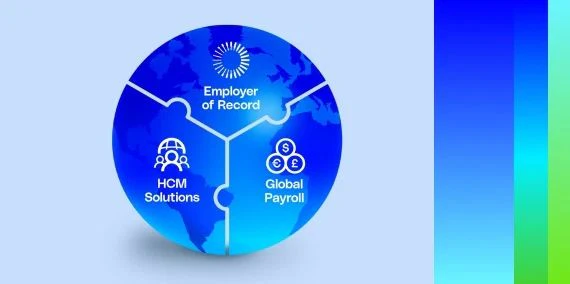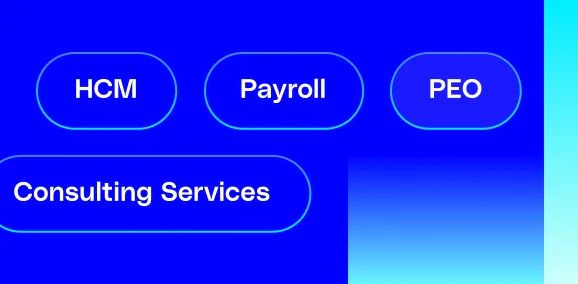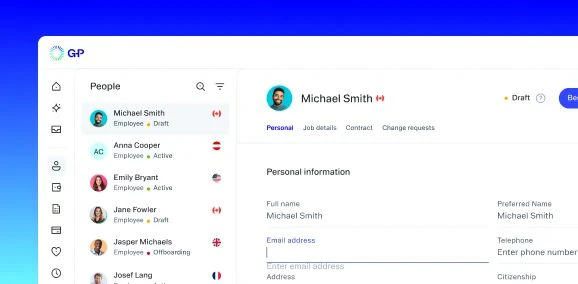A compliant employee handbook is essential for managing global workforces. It creates a shared culture and serves as a reference guide for teams scattered across different time zones.
A good employee handbook covers everything from company values and code of conduct to detailed rules around time off. For HR professionals, an employee handbook builds a foundation for legal compliance and cultural cohesion.
Employment laws vary from country to country, and it takes a lot of effort to meet every requirement in every jurisdiction. AI tools like G-P Gia™ can make the process easier. Gia is an agentic AI that can review and draft compliant employment contracts and HR documents — like employee handbooks — in seconds.
What to include in your handbook: essential policies
Your employee handbook should include policies that address organizational values and operational needs. Here are the most important topics to cover in your handbook:
-
Code of conduct: Define acceptable or unacceptable behavior, dress code, workplace harassment policies, and disciplinary actions.
-
Leave: Clearly explain vacation entitlements, sick leave, public holidays, parental leave, and any country-specific variations.
-
Equal opportunity and antidiscrimination: Outline company stances on diversity, equity, and inclusion.
-
Health and safety: Detail protocols to keep the workplace safe and compliant with legal requirements to protect your company and employees.
-
Payroll, benefits, and compensation: Outline pay schedules, bonus structures, and benefits like health insurance or retirement plans.
-
Technology and data security policies: Set expectations for company technology, software, and how to safeguard confidential information.
-
Remote work and flexible arrangements: Establish guidelines for remote or hybrid work, which are increasingly relevant in global organizations.
Individual departments within your company may need to add customized sections to cover their specific needs and operational guidelines. It’s essential that each of these department additions meet local legal requirements and employee expectations, as well as reflecting your company values.
Gia’s built-in tools for drafting and reviewing employment documents, contracts, and handbooks are incredibly intuitive and efficient. We've been able to create compliant, customized documentation in a fraction of the time it used to take, all without needing to outsource to expensive legal consultants.“
Kenneth Hill
Payroll Manager, Opentrons Labworks
The legal need for employee handbooks and HR policy compliance
Employee handbooks are a critical tool for HR policy compliance. They’re helpful to ensure that your organization adheres to employment regulations at the federal, state, and local levels.
Essential legal guidance to cover may include: wage and hour laws, antidiscrimination regulations, family and medical leave policies, and workplace safety standards. Companies should clearly spell out these requirements to minimize the risk of unintentional violations. And communicate these obligations to employees and regulators.
The challenges of global handbook compliance
Creating and maintaining consistency across multiple jurisdictions can be a headache. To make the process easier, consider using templates and customizing them as needed. Keeping consistency in mind from the beginning can help you avoid the need to make costly, time-consuming revisions.
-
Maintaining consistency across documentation: Messaging around your company’s values and expectations should remain consistent across varying legal landscapes. A well-structured handbook will communicate organization policies and values effectively to all employees, regardless of geography.
-
Manual review and expensive consultant hurdles: Handbook revisions for country-specific adjustments can drain your time and budget. We recommend creating employee handbook templates to define a basic structure you can customize as needed. Gia can automatically adapt your documents and policies to specific jurisdictions, so you can work faster and reduce reliance on external counsel.
Adapt your guidelines for each jurisdiction’s unique legal requirements
Global businesses face the extra challenge of navigating different employment laws in each country of operation.
International employee handbooks should:
-
Customize policies: Adapt guidelines for each jurisdiction’s unique legal requirements (e.g., leave entitlements, employment contracts, regulatory reporting).
-
Incorporate local expertise: Work with in-country legal counsel to make sure handbooks meet all local regulations.
-
Provide local supplements: Include addenda or supplements for region-specific policies to prevent confusion.
An up-to-date employee handbook is your company's best defense against legal action. It documents behavioral standards, informs employees of their rights and obligations, and outlines key policies like antiharassment, antidiscrimination, and grievance procedures. Courts view the handbook as evidence of what a company communicates, so regular review by legal professionals is crucial.
Use Gia to review your employee handbooks for compliance and to compile lists of relevant labor laws for every state, province, or country where employees are located.
Gia provides a wealth of reliable information and makes it easy to access HR-related content across multiple topics, including employment law, compensation, payroll, and benefits. Gia offers region-specific insights, from state-level to international policies, ensuring users can find the relevant information they need with just a click."
Lawrence H
HR Manager, Manufacturing, U.S.
AI and employee handbook best practices
We’ve identified two best practices to keep in mind from the moment you create your employee handbook through customizing it for departments and jurisdictions. One: Use the right tool for the job. And two: always be consistent. Let’s talk about these two best practices in more detail.
Use the right AI tool to create your employee handbook
A lot of AI tools out there scrape the internet and give you unreliable results. And you run the risk of hallucinations and mistakes if you use the wrong tool. When you’re working on employee handbooks and legal compliance, you need an AI tool you can trust.
Gia was created by lawyers to be trusted by HR professionals. It’s the only AI built for HR that offers G-P Verified results and data, thanks to a proprietary knowledge base. Gia gives you quick access to thousands of legally vetted documents, reputable government sources, and expertise from real-world scenarios. It’s a one-of-a-kind global HR agent that allows you to quickly create a compliant employee handbook.
Follow these steps to create your employee handbook:
-
Assess organizational needs: Gather insights about company goals, existing policies, and areas of risk or ambiguity.
-
Compile relevant labor laws: Gather laws for every state, province, or country where employees work. Pro tip: this is as easy as asking Gia to do it for you.
-
Develop policy content: Draft clear, accurate policies that cover all required and recommended areas.
-
Involve stakeholders: Engage leadership, HR, legal counsel, and employee representatives for feedback.
-
Design for access and usability: Create an engaging layout, and make it accessible to all staff.
-
Communicate implementation: Train managers and employees on any new policies, and then gather feedback for continuous improvement. Gia can create an implementation plan for you. And a list of FAQs to prepare you and your team for implementation.
Gia can answer all your compliance questions — you don’t have to be a prompt engineer. Simply ask in your own words and Gia will review existing handbooks policies, identify potential legal risks and compliance issues, and provide actionable recommendations.
If I need to write a policy, I plug in the parameters and jurisdiction, and Gia creates it instantly. If I need to compare sick leave laws in 12 states, I type in the prompt and Gia returns a handy comparison chart. Knowing that Gia’s guidance is based on expert-reviewed, legally vetted sources gives me peace of mind. It lets me spend less time on paperwork and more time on strategic initiatives.”
Katy Burris
Senior Director of Human Resources at Herb Pharm
Consistency
Once you’ve defined universal company standards and supplemented your universal guidance with local addenda, you can move into the maintenance phase. Using a standard format and HR document templates helps set you achieve consistency throughout your organization. Style guides can also help.
Gia can help you maintain compliance and consistency. Here’s how:
-
Reviews your handbook policies against local regulations
-
Identifies conflicts and/or gaps between documents
-
Proactively flags potential compliance issues
-
Suggests specific revisions to create consistency and compliance
-
Automatically generates compliant policies that align with all legal requirements and company standards
Managing document consistency manually could take weeks or months of your team’s valuable time. Gia can complete consistency checks in minutes, giving you a worry-free solution for consistency across jurisdictions.
Global HR compliance? With Gia, it’s done.
Gia is built on legal expertise, not AI guesswork. Its patent-pending AI uses a proprietary RAG model and agentic framework to deliver results 10 times better than the industry standard. Get context-specific guidance across 50 countries and all 50 U.S. states to manage global HR with speed, clarity, and confidence.
Gia draws from a robust knowledge base built on a decade of global compliance expertise, a million real-world scenarios, over 100,000 legally vetted articles, and more than 1,500 government sources.
With Gia, you get unparalleled speed and trusted compliance — all on your schedule. Get legal-grade answers instantly and make global HR compliance easy.




















